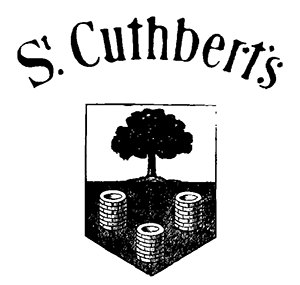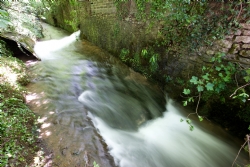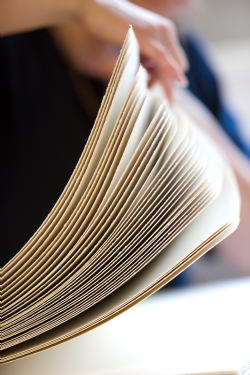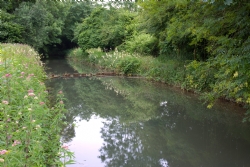St Cuthberts Mill Paper
Call or email:
+44 (0)1749 672015
sales@stcuthbertsmill.com
St Cuthberts Mill Paper
Watercolour
Printmaking
Digital Fine Art

Re-using and Protecting, St Cuthberts Mill and the Environment
Papermaking is an ancient art, the foundations of which are still used in papermills today to create papers from natural materials. At St Cuthberts Mill we endeavour to minimise any environmental impact, whether that’s on our local environment — the beautiful Somerset countryside surrounding our mill — the larger global environment where we source our raw materials, or the impact of waste materials from the manufacture of our paper.
St Cuthberts Mill’s natural environment
St Cuthberts Mill is very privileged to be situated in a beautiful area. To explain our location, the mill is located in the foothills of the Mendips, surrounded by lush green English countryside, on the banks of the River Axe which is full of wildlife. The mill takes great pride in ensuring that its impact on the local ecosystem is negligible. The mill has been here for centuries and runs in synergy with the local environment. The mill’s surroundings are full of life, and is the habitat for dragon flies, trout, heron, kingfishers, rabbits, foxes, roe deer, ducks, woodpecker, eels, grass snakes, butterflies to name a few.
Protecting the pure water of the River Axe
The water that forms the life blood of St Cuthberts Mill comes from the River Axe. The river rises only a mile upstream in the magnificent Wookey Hole cave system. The pure waters around St Cuthberts Mill have a high level of biodiversity with abundant aquatic life. We have a licence to use the water to make paper. The natural cleanliness makes it superb for making great paper. The mill takes great care to return the used water back into the river as clean as we find it. To do this, St Cuthberts Mill has an efficient water treatment plant. It removes any traces of papermaking fibres or additives from the water to ensure there are no contaminates that could potentially enter the river. The water is regularly put through a series of vigorous tests and is externally monitored by the UK Environment Agency.
Recycling waste paper and fibres
As a papermill, St Cuthberts Mill has the facilities to recycle our own paper waste. We successfully strive to re-use our waste materials, with no papermaking waste being destined for landfill. As a result, most of our papers contain a percentage of fibres we have recycled. We also use our waste products to make an archival grade card used in our sheet packaging. Even the fibres that are extracted from our water treatment plant are regenerated into new products.
Energy efficiency
Energy is needed to make paper; heat is required to dry the paper and to activate the sizing agent (this controls the absorbency level of the paper). St Cuthberts Mill operates with a modern energy efficient boiler that operates with good air emissions. We use inverters on our pumps to make them energy efficient, and energy saving devices are used throughout the site. We are continuously looking for ways to improve our energy efficiency.
Raw materials
The biggest raw materials used to make paper are cotton and pulps sourced from wood. At St Cuthberts Mill we source only high quality and sustainable raw materials to turn into our paper.
Cotton fibres
Cotton is a natural fibre that is used at St Cuthberts Mill to make Saunders Waterford®, Millford and Somerset®. St Cuthberts Mill uses cotton linters, these are the long, silky fibres attached to the cotton seeds and are a by-product of the textile industry. Cotton is grown as an annual crop, primarily for the textile industry who use the long cotton fibres. With cotton crops the whole plant is used. The seeds are pressed to make cotton seed oil for the food industry, the seed hulls are used as animal feed and the remaining stalks and leaves left after the harvest are ploughed back into the soil to act as a soil enricher.
Wood based pulps
Bockingford® uses high quality woodfree wood pulps as its main ingredient. These pulps are sourced from managed forests in Europe. All the pulps are compliant with EU Timber Regulations (EUTR). Being compliant with EUTR means St Cuthberts Mill will never use illegally logged timber in our papers. Strictly NO pulps sourced from rain forests or from deforestation are used in our papers. Only pulps from trees grown in managed forests are used. In managed forests, the trees are grown with the intention of eventually being harvested. They are managed in synergy with the natural lifecycle of the trees, regenerating the forest with a constant circle of plantation, growth and harvesting. These huge renewable forests naturally absorb carbon dioxide from our atmosphere and grow turning it into wood, releasing oxygen into the air. They are managed to maintain their biodiversity and are ecologically sound to ensure they are sustainable for future generations.
Sustainability of St Cuthberts Mill’s papers
St Cuthberts Mill endeavours to work in harmony with its natural environment. We take extreme care to never pollute or damage the beautiful area where we live or harm the river that feeds us. We carefully source our raw materials from sustainable sources and strive to re-use or regenerate all our manufacturing waste.



